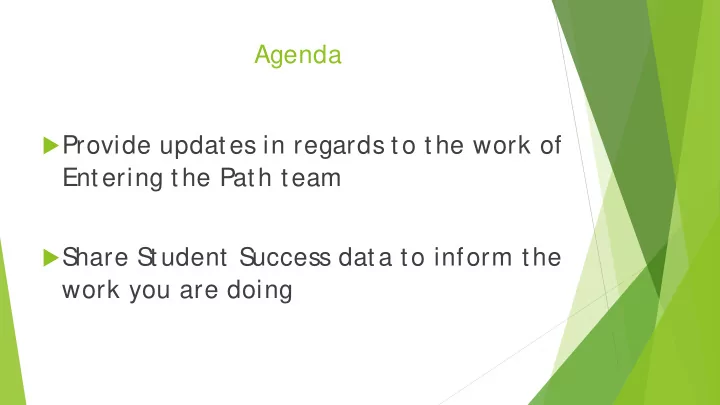

Agenda Provide updates in regards to the work of Entering the Path team S hare S tudent S uccess data to inform the work you are doing
S S S P (What does S S S P stand for? ) S S S P was established in 2012 by the S eymour-Campbell S tudent S uccess Act “ to increase California community college student access and success by providing effective core matriculation services” The goals of S S S P are: Ensure that students promptly define their educational and career goals Ensure that all students complete their college courses Persist to the next academic term Achieve their educational obj ectives through the assistance of the S S S P Program process
S S S P Categories Orientation Assessment for Placement Counseling, Advising, and Other Education Planning S ervices Follow-up services to At-Risk students
S S S P How much funding do you think CRC received for the current fiscal year for S S S P? A. $1.2M B. $500,000 C. $1.5M D. $2.4M Funding is performance based (based on the number of students who receive services)
Entering the Path
Entering the Path Focus: Update the website content related to new students Completely redesign the onboarding/ matriculat ion process
Redesigning the Matriculation/ Onboarding process Purpose: The purpose is to implement a redesigned equity- focused matriculation/ onboarding process that would allow prospective students to complete the admission steps, including enrollment into courses, in a timely manner.
Why Redesign? Current Onboarding Process for U.S . Citizens who are CA residents with S S N# Complete Application – CCC Apply Complete F AFS A/ California Dream Act Complete Online Orientation Assessment Test Attend Group Counseling Register for classes
Redesigning the Matriculation/ Onboarding process On average, what percentage of the students who complete the application to CRC enroll in the in the Fall semester?
Why Redesign? Current Onboarding Process Fall, 2015 Fall, 2016 Fall, 2017 % Headcou % Headcou % Headc Enrolled nt Gap Enrolled nt Gap Enrolled ount Gap Ethnicity - - African 36.3% 568 10.9% 39.7% 575 9.9% 38.3% 567 -6.6% American 47.6% 727 0.4% 52.1% 787 2.5% 46.8% 926 1.9% Asian 18.2 59.8% 169 12.6% 67.8% 152 % 57.8% 204 12.9% Filipino Hispanic/ 49.8% 1105 2.6% 50.9% 1161 1.4% 45.6% 1282 0.7% Latino - Native 40.8% 49 -6.4% 42.1% 38 7.4% 40.0% 55 -4.9% American Other - Non- 20.0% 5 27.2% 50.0% 2 0.5% 0.0% 3 -44.9% White - Pacific 43.2% 74 -4.0% 44.4% 54 5.1% 47.1% 51 2.2% Islander - 40.6% 69 -6.6% 43.5% 62 6.0% 26.0% 73 -18.9% Unknown 50.1% 757 2.9% 49.9% 721 0.4% 45.2% 770 0.3% White 47.2% 3523 49.5% 3552 44.9% 3931 Total
S hort-term Phase 1 of the Redesign Process Action Steps (short-term) Review the email and other communication that new students currently receive; make adjustments to clarify the process • Students currently receive multiple email communication from district. Some of these emails are confusing and redundant Incorporate components of the online orientation into the Group Counseling process. Guide students directly to the Group Counseling after completing the application • Students receive the same information during the Group Counseling session similar to the information they receive through the online orientation. Making the online orientation optional will streamline the process • The online orientation system is currently experiencing technical issues. The system does not show every student who complete online orientation Increase capacity to serve new students by adding more Group Counseling sessions. Add computer labs that can accommodate more students. • Ensure that students who have questions are directed to one office for consistency of messaging; • Provide training to Student Services staff to ensure that everyone understands the steps for new students to ensure consistent messaging in regards to assessment, AB 19, etc. • Review the current outreach efforts to students going through the admission steps; make adjustments as needed
At-Risk S tudents
At-Risk S tudents Categories S tudents without a declared maj or (undecided students) 1. S tudents who have earned 15 units or more but do not 2. have comprehensive education plan on file S tudents who have earned 50 or more units who are not 3. close to completing their program S tudents whose Grade Point Average (GP A) is between 2.0 4. – 2.3 S tudents on Academic Probation 5.
At-Risk S tudents Approximately, how many students do we have enrolled in the current semester who have completed 15 or more units but do not have comprehensive education plan on file? A. 500 B. 1,500 C. 3,000 D. 4,000
S tudents who have earned 15 units or more but do not have comprehensive education plan on file Total number of students = 2,971 Of which 1,630 or 54% have 30 units or more 939 are African American and Hispanic/ Lat ino
At-Risk S tudents Approximately, how many students do we have enrolled in the current semester who have completed 70 or more degree applicable units? A. 50 B. 200 C. 600 D. 1,000
S tudents who have earned 50 or more degree applicable units Total number of students = 1,314 211 have attained either a degree or certificate 562 of the students have 70 or more degree applicable units 54 students have over 100 units and no degree or certificate
S tudents whose Grade Point Average (GP A) is between 2.0 – 2.3 Total number of students = 1,220 Of these, 555 are African American and Hispanics
S tudents on Academic Probation 1 and 2 Total number of students = 1,425 Of these, 225 are African American and Hispanic
Things to consider What can we do in a short-term to serve these students? What are the structural systemic barriers that need to be removed to serve these students?
Recommend
More recommend